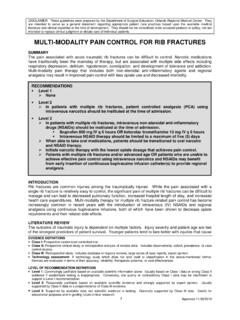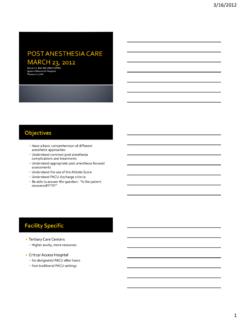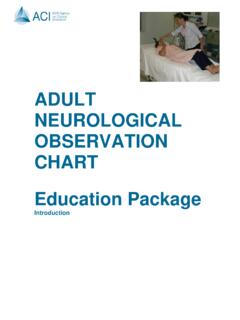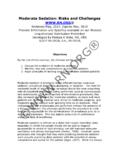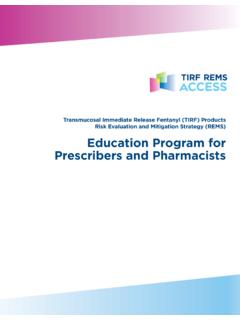Transcription of HOSPITAL DRUG ADMINISTRATION PROTOCOLS St. Vincent’s ...
1 HOSPITAL DRUG ADMINISTRATION PROTOCOLS St. Vincent s HOSPITAL melbourne Patient controlled analgesia (PCA) Page 1 of 4 Refer also: HOSPITAL Clinical Manual (Intranet) Acute Pain Service Manual (Department of Anaesthesia) Description: Patient controlled analgesia (PCA) pain relief technique where the patient can, when discomfort is felt, self administer a pre-set bolus dose of narcotic analgesic by pressing a button connected to a special PCA pump.
2 The PCA pump can be set to deliver a specific dose, a specific lock-out period, and if required a ceiling on the number of doses over each hour. In addition, a constant rate infusion may be provided as background analgesia . Special Precautions: 1. PCA solutions must be administered via: a) a dedicated line; or b) the side arm of an IV line with a non-return valve on the main IV line to prevent narcotic solution reflux up the main line if the catheter or main line become obstructed. c) Solutions to be made up in Terumo Syringe Luer lock 60mls 2.
3 Regulation of Bolus Dose, Rate, and/or Lock Out Period: Refer HOSPITAL Clinical Manual (Intranet): Drugs Schedule 8 Intravenous ADMINISTRATION of S8 Drugs. Changes in the preset dose and/or lock out period can ONLY be varied according to the prescription on the analgesia Infusion Treatment Sheet. Prescribing Information: Currently approved standard solutions: 1. Fentanyl 1000 mcg in 50 mL = 20 mcg/mL Usual Preset Bolus Dose = 20 to 30 mcg 2. Morphine 100 mg in 50 mL = 2 mg/mL Usual Preset Bolus Dose = mg but may range from to mg 3.
4 Hydromorphone 5 mg in 50 mL = mg/mL Usual Preset Bolus Dose = mg Acute Pain Service or Palliative Care prescription only 4. Oxycodone 100 mg in 50 mL = 2 mg/mL Usual preset bolus dose = 1mg Acute Pain Service prescription only Order should be written on the analgesia Infusion Treatment Sheet (SV 754). Protocol last reviewed JULY 2014 Due for review JULY 2017 HOSPITAL DRUG ADMINISTRATION PROTOCOLS St. Vincent s HOSPITAL melbourne Patient controlled analgesia (PCA) Page 2 of 4 Preparation of PCA Solution: NS* = Normal Saline sodium chloride Fentanyl 1000 mcg/50 mL = (2 x 500mcg/10mL) amps added to syringe, making up to 50 mL with NS*.
5 Final concentration 20 mcg/mL. Morphine 100 mg/50 mL = (3 x 30mg/mL) + (1 x 10mg/mL) amps added to syringe, making up to 50 mL with NS*. Final concentration 2 mg/mL. Oxycodone 100 mg/50 mL = (2 x 50mg/mL) amps added to syringe, making up to 50 mL with NS*. Final concentration is 2 mg/mL. Hydromorphone 5 mg/50 mL = ( x 10mg/mL) amp added to syringe, making up to 50 mL with NS*. Final concentration is mg/mL. MIX CONTENTS THOROUGHLY by gently shaking the syringe end to end. The narcotic syringe is prepared by either two Registered Nurses (Division 1), or a Medical Officer and Registered Nurse (Division 1), and an appropriate entry made in Drug of Addiction Register.
6 ADMINISTRATION : An infusion pump specifically designed for PCA ADMINISTRATION must be used ( Alaris). Such pumps can be programmed, have lockable controls, a secure compartment for the PCA IV solution and a button for patient to trigger doses. Nursing Observations/Actions: Ceasing a PCA: 1. Refer to the Special analgesia Observation Chart (SV 167). 2. Do NOT give additional opioids/narcotics unless ordered by the Acute Pain Service or unit registrar. Tramadol can be given prn if ordered.
7 3. The PCA drug orders and settings of the PCA pump should be verified: - at each change of shift. - when syringe is replaced. The following criterion provides staff with the knowledge to confidently identify when a patient is ready to have their intravenous PCA ceased. These patients must reach certain criteria in order for nurses to initiate cessation of the PCA and change to oral analgesia . CEASED CRITERIA C= Current or planned activity produces mild pain in relation to FAS (Functional Activity Score) E = Evidence of gut function/motility A = Analgesic use is low, < 40mg IV PCA morphine equivalent per 24hrs.
8 For other opioids, consult medical staff/pharmacist for morphine dose equivalent. S = Step down analgesia is charted E = Exception for nurse cessation is presence of: Chronic pain, opioid tolerance, history of substance abuse, adjuvants such as ketamine or nurse unsure. D = Discuss changes with patient and report uncontrolled pain. HOSPITAL DRUG ADMINISTRATION PROTOCOLS St. Vincent s HOSPITAL melbourne Patient controlled analgesia (PCA) Page 3 of 4 Step down analgesia : Registered Nurses Responsibility: Process for CEASING a PCA.
9 patients can be identified as appropriate for ceasing their PCA by nursing staff using the CEASED criteria during the patient assessment All criteria must be met before nursing staff can discuss ceasing the PCA with medical staff. The prescriber can then chart the appropriate step down analgesia . Discuss plan to change to step down analgesia with the patient. Inform them the PCA will be ceased and they will be prescribed oral analgesia for pain. Administer oral opioid approximately 1 hour prior to stopping PCA.
10 Cease PCA and continue with oral regime as charted. Continue evaluation and documentation of pain scores on Adult Observation and Response Chart (SV 978) Enrolled nurses and graduate nurses need to seek endorsement by a senior nurse or nurse in charge if they believe a patient is suitable for CEASED. patients that have had small PCA requirements* or short term use* may not need slow release (SR) medication ( : Oxycontin , Targin ) charted. Immediate release (IR) PRN medications ( : Oxycodone) may be sufficient with regular Paracetamol.

